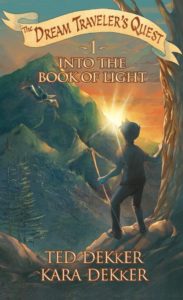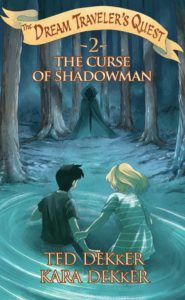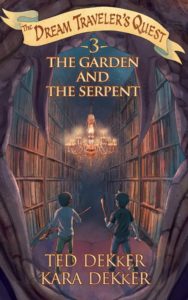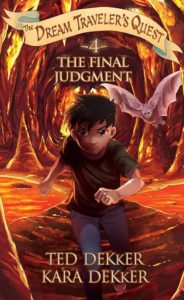
Also by this author: The Promise, The Drummer Boy, Sinner, Green, Into the Book of Light, The Curse of Shadownman, The Garden and the Serpent, The Final Judgment, Millie Maven and the Bronze Medallion, Millie Maven and the Golden Vial, Lulu The Lost Rubber Ducky, Monty and the Tree of Light, Barton the Dream Jumper
Published by Outlaw Studios on September 2018
Genres: Fiction, Christian, Children's, Fantasy
Goodreads

What if you could find a way to enter another reality full of wild and life changing adventure? And what if every time you fell asleep you woke up in that other reality? Welcome to the world of Theo Dunnery, a twelve year-old boy who feels alone and full of fear when he stumbles on an ancient book that draws him into another world.
In that world, he learns he must complete a quest to find the Five Seals of Truth if he is to conquer his fears. Facing great odds and many enemies, Theo sets off on the adventure of a lifetime to discover who he really is as the son of Elyon, and overcome the darkness that has haunted him for so long.
Join Theo on The Dream Traveler’s Quest, one story told in four chapter books. Read all four and discover the truth for yourself.
If you haven’t heard of this series, you aren’t alone. The Dream Traveler’s Quest was released without much notice or fanfare in late 2018 and…well…that’s kinda been it. The four-book series is aimed at ages 7-12 and pairs with the Beyond the Circle duology that Dekker released the same year.
In both series, the main character goes on a quest to discover the Five Seals of Truth. The Seals are five statements taken from Dekker’s non-fiction book The Way of Love:
- God is infinite.
- I am the Light of the world.
- Seeing the Light in darkness is my journey.
- Surrender is the means to seeing the Light.
- True love is the evidence of being in the Light.
So The Dream Traveler’s Quest is a journey of self-discovery, of coming to understand the nature of God and our subsequent nature as his children. In the series, Theo Dunnery (pronounced Taay-o—a callback to Theodore Dekker’s childhood nickname) stumbles upon a Book of History in his school library and finds himself transported into another world: one in which the distinctions between good and evil are more visual. A Mystic named Talya (who also features heavily in Beyond the Circle) gives Theo the quest of finding all five Seals of Truth.
A Theological Analysis | The Dream Traveler’s Quest
Because theological/spiritual teaching lays so much at the heart of The Dream Traveler’s Quest, I highly recommend that you seek out and understand—and agree with!—the concepts Dekker is teaching. These books aren’t just mindless adventures, nor are they simplistic morality tales. Rather, Dekker’s theme is rather complex and sometimes confusing, especially when placed into the context of middle-grade fiction.
And this theology has not been without its detractors. Many have felt that there is an underlying current of panentheism in Dekker’s theology that they find problematic. This plays out in several distinct ways in Beyond the Circle but there’s one primary theme that also plays out in The Dream Traveler’s Quest.
Through the second seal, Dekker seems to imply that becoming the light of the world is a matter of discovering what you already are and not the process of becoming something new. If true, this would clash with any Christian idea of the necessity of repentance. While Dekker’s actual theology is more nuanced, that nuance doesn’t always come through in the books.
In The Curse of Shadowman (Dream Traveler’s Quest #2), Theo meets Maya—a Horde girl who loves Elyon. In the Circle Trilogy (Black, Red, White), the Horde find salvation when they drown in Elyon’s red waters. It’s a symbol of spiritual regeneration and physical baptism. But in this series, we meet a family that loves Elyon but chooses to remain Horde.
“But if you believe in Elyon, why are you still Horde?” Theo asked. “Why haven’t you been to the Red Lakes to heal yourself?”
“Talya is teaching me and my mother that we are beautiful. Even though our skin may not be, our beauty lies inside.”
The concept that true beauty comes from within and that one’s inward change is better than one’s outward change is all nice and good, of course. Except—except—that we are explicitly in a world where the inner nature is expressed outwardly. By not recognizing that, Ted Dekker creates a theology where the Horde can know Elyon, serve Elyon, love Elyon, but never drown in the Lakes.
I’m not convinced that this is what Dekker necessarily believes, but it is how it comes across. Ted Dekker’s mysticism certainly leans toward (okay, through) the fringes of orthodoxy, but his actual beliefs—when well-articulated, clarified, and challenged—are thought-provoking and challenging. That doesn’t transfer into The Dream Traveler’s Quest and it can make for some concerning teaching.
As with all books you give your children, read it yourself first. Understand it. Be prepared to answer questions about it. Be prepared to ask questions about it. This isn’t The Circle Trilogy. Dekker isn’t outlining the basics of redemptive history. He’s detailing a very complex and nuanced belief about human identity in Christ. Make sure that you agree—or are at least willing to discuss with your child where you disagree—before you let them read.
A Literary Analysis | The Dream Traveler’s Quest
Just by virtue of the fact that I’ve already written 500 words on the theological overtones in The Dream Traveler’s Quest, it might come as no surprise to you that Ted and Kara Dekker violate the rule of “Show, don’t tell” in pretty much every fashion.
The story suffocates under the weight of its intended teaching. (And this isn’t unique to The Dream Traveler’s Quest, Beyond the Circle deals with the same issue.) The Five Seals are a structure that Theo and his friends must awkwardly weave around. This makes the storyline feel very contrived as there are so many Deus ex Talyas that I lost count. It’s somewhat akin to a video game. There are five levels. Five specific goals. None of these things necessarily lead from one to the other, but exist as disparate stages. This becomes especially evident in The Garden and the Serpent (Dream Traveler’s Quest #3) when Justin (aka Elyon) specifically lays out the quest like this:
“Through this door you will find a world—a temple, if you will. In that temple, you’ll encounter three rooms on three different levels…Completing one challenge will reveal the door to the next room.”
“Sounds like a video game.”
The story often has the feel of Talya/Justin/Elyon putting Theo and his friends through a video game training simulation. (Obscure Theory: That’s exactly what is happening. Theo is in a Skin simulation.) The story doesn’t flow, never really seems organic, and gets forced into absurdities to fit around the plot device of the Five Seals.
(SPOILERS IN THIS PARAGRAPH) View Spoiler » (END SPOILERS)
So from a plotting perspective, The Dream Traveler’s Quest is a bit of a mess. Not just in the jerkiness of the plot, but also in some of the most random things. In The Final Judgment (Dream Traveler’s Quest #4), Kara and Ted Dekker need all three of their heroes—Theo, Annelee, and Danny—to be in the same place at night, which they do so by way of a sleepover. Except mixed-gender sleepovers might be frowned upon, which is something mentioned by Theo’s dad but then hand-waved away with the excuse “We need to work on a school project.” I can almost hear in real-time as the authors try to come up with a reason to get them all in the same room, write the scene, realize its flaw, and then just roll with it anyway.
Sometimes, the series deviates from established canon, though whether it’s intentional or unintentional, I couldn’t tell. Even the series’ title—Dream Traveler’s Quest—is suspect. A large part of the Circle Trilogy and the Lost Books is devoted to the idea that Other Earth is not a dream but a future Earth. The other major thing is that both Shataiki and Roush have the ability to cross worlds without a Book of History. The whole plot of the first four Lost Books (Chosen, Infidel, Renegade, Chaos) is keeping the 7 Original Books of History out of the talon of Marsuuv, a Shataiki queen, so that he cannot bridge the worlds. But here, just, you know, whatever.
A Character Analysis | The Dream Traveler’s Quest
Another issue this series runs into is that it is dealing with a number of already-established characters. Michal and Gabil, in particular, seem nothing like “themselves” (as portrayed in the Circle Trilogy). They were always the Timon and Pumbaa of the series—lovable sidekicks who can both provide comic relief, exposition, and butt-kicking, if needed. The Dream Traveler’s Quest makes them seem like caricatures of themselves. For instance:
“Sugar? What is sugar?” Gabil asked.
“White powder to make things sweet. You know, sugar.”
“White powder like sand? You use sand to make things sweet? You are funny, Theo!” Gabil fell to the ground, rolling around, laughing uncontrollably like a small child.
This is Gabil, slayer of Shataiki, an analogue of the archangel Michael, not knowing what sugar is. It doesn’t fit the character. It’s the nature of the character dumbed down to a child’s level, but not made simpler, just more juvenile.
Gabil isn’t the only returning character that seems toothless. The Curse of Shadowman (Dream Traveler’s Quest #2) introduces us to the Horde High Priest Ba’al. Ba’al is a major villain in Other Earth, featuring in the Circle, Lost Books, the Blood Book, and Beyond the Circle. There’s a lot of buildup to him—I thought he was Shadowman—but then his storyline sort of fades as Shadowman enters.
Shadowman is a humanoid figure, mentioned once to be called Vlad (which is an allusion to Immanuel’s Veins???), who ends up being Marsuuv—perhaps impersonating a Leedhan?—after all. It’s as if Dekker can’t decide who the big bad should be, or what his own lore is, but wants to ram all the villains into what amounts to maybe a 30k word story over four books.
There’s also the needless introduction of a younger Roush named Stokes. Stokes is…well, let’s just say I wasn’t a fan of the character. If you thought the paragraph above from Gabil was puerile, then wait until you see Stokes.
I get that some of this is because the characters are being adapted into language/concepts for children, but you cannot take established characters and change their character because you’ve changed the audience. Just use all brand-new characters or keep the old characters with the appropriate personalities. Either works. This doesn’t.
On the plus side, the heroes are well-written. We understand Theo’s fears and motivations quite well. Annelee’s redemptive arc comes a bit fast, but no faster than expected in a children’s chapter book. Danny is a bit underdeveloped and his blindness is used as a schtick rather than a substantial character with disabilities, but he’s still a fun character that will give young readers a perspective outside of their norm.
An Editorial Analysis | The Dream Traveler’s Quest
Simply put, this book needed an editor. It’s obvious that it didn’t have one. From the occasional typo to internal inconsistencies to inconsistencies with the Circle canon, a lot of issues that I have with this series could have been solved by good editing.
And this really shows the pitfalls of self-publishing, even for established NYT best-selling authors. I don’t know whether Ted Dekker intended on self-publishing this through Outlaw Press from the beginning or, and this is my theory, they pitched the idea to Revell (who published the Beyond books) but Revell didn’t bite on it.
A publishing team would have run this through the wringer and turned the concept—a Circle-themed children’s book series—into a winner. Instead, we get something that reads like Dekker fan-fiction you would have found on his forum circa 2009. Developmental editing, structural editing, line editing, copy editing, proofreading—it needed it all and it was painfully obvious that it didn’t have it. As someone who has read a couple of Dekker first-drafts, this reads like a Dekker first-draft.
Ted wrote this with his daughter, Kara. I’m not quite sure what that means. My understanding is that The Dream Traveler’s Quest was Kara’s project—she initiated it, she plotted it, she executed it. If it’s like the process Ted took with The Blood Book, there was an initial conversation about direction and scope, and then the co-author wrote the rough draft and Ted gave it a second pass.
I don’t want to pin any failures of this series on Kara. I know how hard it is to come into an established world and try to find your own vision and voice. That dichotomy might account for some of the tonal problems this book has when relating it to the rest of the Circle. (You get flashes of this in the last two Lost Books, Lunatic and Elyon, co-authored with Kaci Hill.) It is super difficult to come into an established world and expand on it, particularly when the standard of the Circle Trilogy is an impossible bar.
What I Would Have Done | The Dream Traveler’s Quest
I want to be clear. I count Kara and Ted as friends. I don’t lightly make criticisms like this. I strongly considered not reviewing these books at all. And if this had been any normal mediocre self-published middle-grade fiction, that what I would have done. But this is Ted Dekker. Ranked as one of the best thriller writers of all-time. Over ten million copies sold. NYT best-seller. And this is The Circle. I can’t even begin to tell you how Other Earth has influenced my own reality. There’s always an interesting philosophical conversation to be had in whether or not an author has the right to change the world they’ve created and into which fans have invested themselves (see: Lucas, George or Rowling, JK) and by-and-large, I’ll side with the author. But that also means I hold the author responsible for changes that harm the overall integrity of the work.
The Dream Traveler’s Quest probably isn’t that bad. I read some other middle-grade fiction to get an idea of the literary style: Captain Underpants, Adventures in Odyssey, Dead Sea Squirrels, etc. And, ok, they are sometimes just as corny and childish. The difference is that they are not building on an established property using established characters. There’s so much baggage—good and bad—that comes with the Circle, that it makes it very hard to write a story using those themes and characters to a completely different target audience.
So how could this have been better? What would I have done if I had been in the writer’s seat? This is one time I feel like I can’t criticize unless I also give solutions. So, Ted and Kara, if you had hired me as an editor, here’s what I’d say:
- Build your world. Remember that this will be young readers’ first time in the Circle.
- Simpler is better. I would have avoided the whole five seals storyline altogether, but if you must have it, pick a simple moral theme that best exemplifies the message of the seal. For instance, “Love is the evidence of being in the light” gets simplified to “Love your enemy.” Kids need a morality that is concrete, not conceptual and mystical.
- Either use all new characters or don’t change the personalities of the established characters.
- Don’t use side projects to introduce new elements. (You know, like how a thing in Star Wars canon was decided by Fortnite. Don’t do that.)
- Take out the video-game, level-by-level element. Let the main characters learn the lessons of the seals, but through story and not through didactic teaching.
- Show, don’t tell.
- Make sure your characters have depth. Streamline the number of characters, focus on depth.
- Hire an editor. With some more work, this could have gone from Dekker fan-fic to legit.
Individual Reviews | The Dream Traveler’s Quest
I wanted to write this review set because there had not been any substantive reviews of the series. On the Ted Dekker Store website, nearly every review is either “I GOT THIS FOR MY GRANDCHILD FIVESTARS DID NOT READ” or “I STILL HAVE NOT RECEIVED THIS FIVE STARS” or—a real review, by the way—“I had to throw them out. Per the exorcist Fr Chad Ripperger. Your book contained demonic windows.”
Literally nobody has actually given a substantial, reasoned response to these books. Hopefully this isn’t overkill. Or, at least, it’s well-received overkill. Let me know in the comments. Anyway, onto the individual reviews. One paragraph snippets here, and then click through for the full review.
 Into the Book of Light (The Dream Traveler’s Quest #1)
Into the Book of Light (The Dream Traveler’s Quest #1)
Theo’s introduction to Other Earth comes as the librarian, Mrs. Friend, hides Theo from the school bully (and principal’s son), Asher. While in a special room in the library, Theo uncovers a Book of History, blood from his nose hits the page, and he find himself transported to the other realm.
On the other side, he meets some familiar characters and learns that Talya (see Beyond the Circle) is sending Theo on a quest to discover the Five Seals. Seal One: Elyon is infinite and cannot be threatened by anything, ever.
As it introduces Theo to Other Earth and Elyon, Into the Book of Light is easily the strongest of the series. Theo overcoming Shataiki through the power of Elyon plays out perfectly for helping Theo deal with his Real Earth bullies—and they’ll help your child as well.
 The Curse of Shadowman (The Dream Traveler’s Quest #2)
The Curse of Shadowman (The Dream Traveler’s Quest #2)
The Curse of Shadowman takes place a couple weeks after book one and we see Theo desperate to go back to Other Earth. We’re also introduced to Annelee, who ends up being the butt of school bully Asher’s jokes this time around. While Theo is still in school, the young Roush named Stokes appears and tells Theo that he needs to come back to Other Earth and bring Annelee with him.
Theo and Annelee appear in Other Earth and go with Michal, Gabil, and Stokes to Mount Veritas. In book one, the journey to Veritas goes through a Roush village. In The Curse of Shadowman, they take a different route and end up meeting a Horde girl named Maya who loves Elyon. It’s subtle, but I think the Dekkers are referencing Jesus’s meeting with the Samaritan woman in John 4. In this conversation, Jesus reveals himself as Messiah and tears down the societal and ethnic constructs that separated Jews and Samaritans. The message from Jesus: You can be a Samaritan and follow Jesus too.
It’s a good theme that is poorly executed given the world’s established mechanics. If you’re reading this with no previous knowledge of the Horde, if you’re reading this as a standalone lesson about inner beauty, then great! But if you’re reading this within the context of the Circle, then it simply doesn’t hold up.
 The Garden and the Serpent (Dream Traveler’s Quest #3)
The Garden and the Serpent (Dream Traveler’s Quest #3)
The Garden and the Serpent, the third book in this series, picks up about a week after book two. And just like Theo introduced Annelee to Other Earth in The Curse of Shadowman, the two find a third friend—Danny—to join them this time. The two (for AnneLee stays home) travel with Stokes to the Land of the Mystics where they meet Justin (aka Elyon or the boy.) And it’s in this realm that they are shown how to find the third seal. In the weakest plot construct of the four books, the rest of the book plays out like a video game.
It’s a completely contrived plot that isn’t that well-constructed and doesn’t make a whole lot of sense. Both boys are confronted with their deepest fears, but learn to put on the glasses of the Kingdom which enable them to see past their fears and feel confident in their identity as a child of Elyon. Again, it’s a powerful theme—the plot just doesn’t really do it justice.
 The Final Judgment (Dream Traveler’s Quest #4)
The Final Judgment (Dream Traveler’s Quest #4)
The Final Judgment (Dream Traveler’s Quest #4) wraps up the series by directing Theo to seals four and five. Unlike the other books, there’s no delay here. Asher, the school bully, has taken the Book of History and entered Other Earth. It’s up to Theo, Annelee, and Danny to crossover and stop whatever nefarious scheme the Shataiki have planned for him.
The final two seals carry the theme of there not being any fear in love. This is what the series has been building toward. Theo needs to learn to love his enemy and his enemy as Elyon sees him. He needs to see Asher as a child of God.
While this was good in concept, the execution was lacking. With some added time in development and plotting, these really good have been great. Instead we get glorified Dekker fan-fiction as the major turn of the book, and of the series, just falls flat and leaves The Dream Traveler’s Quest to just sort of sputter to an ignoble end.
